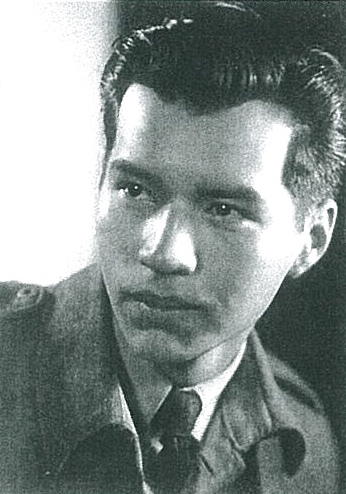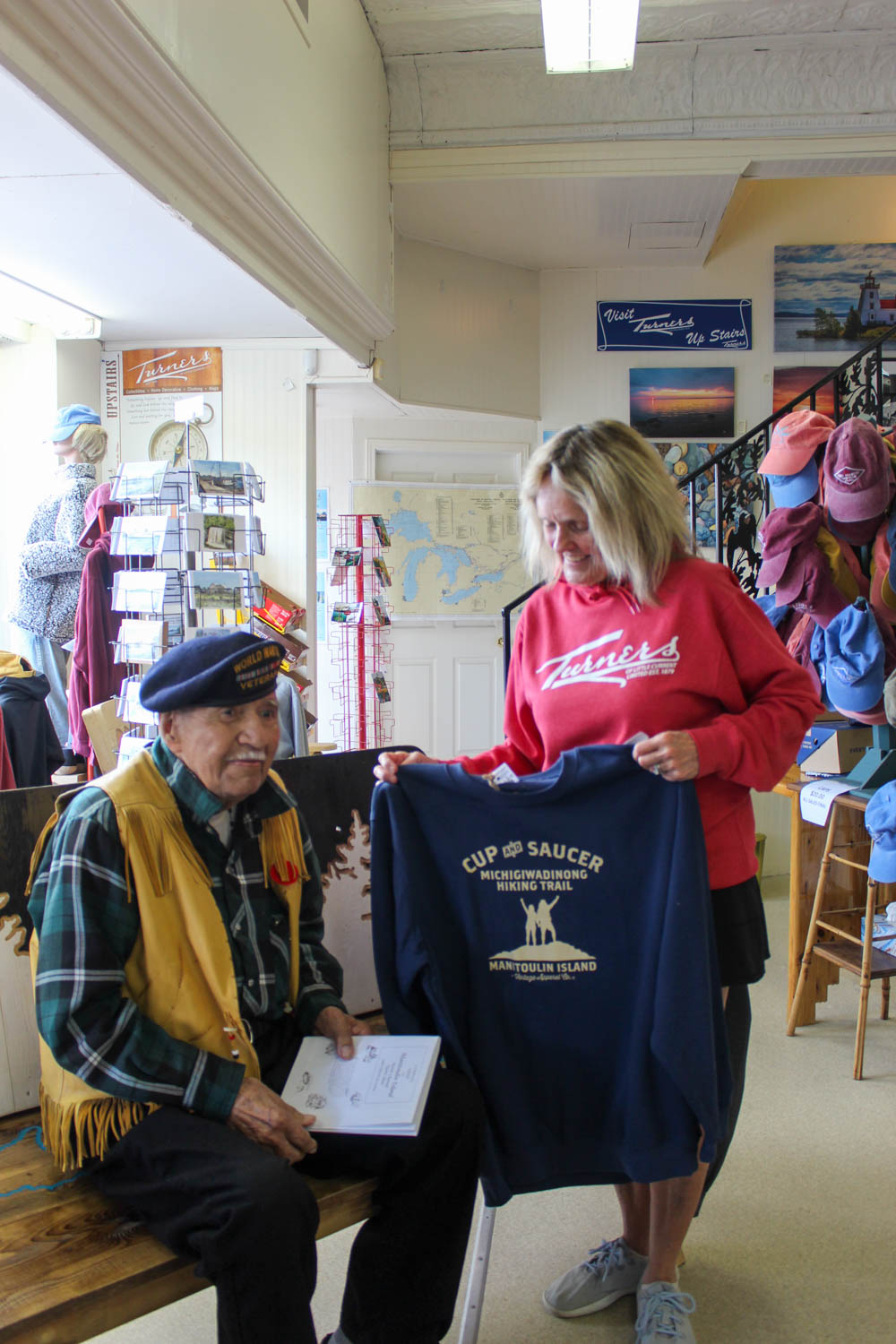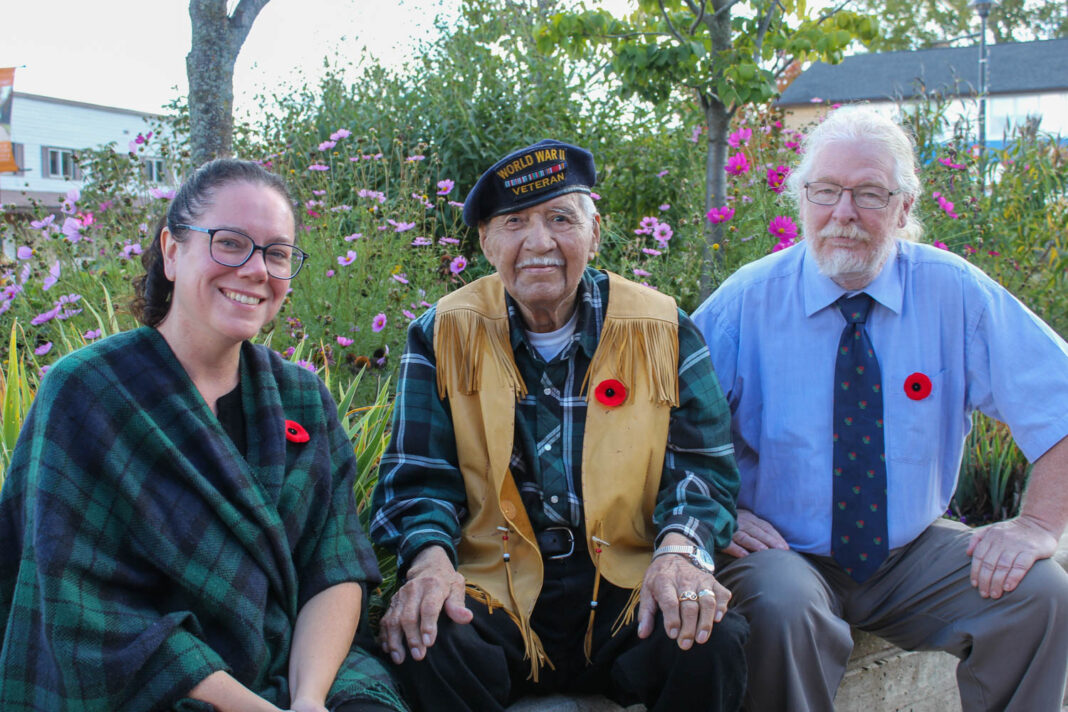MANITOULIN—Manitoulin had a very special visitor to the Island recently, Justin Roy, Manitoulin’s last First Nations World War Two veteran.
“If I can’t make it (to Manitoulin) next year, I’ve gone moose hunting,” quipped Mr. Roy who turned 99 on August 19.
Mr. Roy visited the Island for a little over a week earlier this fall with his friend Cindy Beatrice, who provides health care aid. “We have been staying at Lillian’s Crafts (owned by Lillian Debassige) in M’Chigeeng and hopefully next year we will be able to come to the Island for a month. We already have a spot booked for next year.”
“We have been taken all over the place on the visit,” stated Mr. Roy, who pointed out he had a ride on a pontoon boat (“We had a blast”) and went fishing with his nephew Wally Corbiere and his wife Menesa where they caught walleye and bass. “They are great people,” he said.
“This is my first trip to the Island in a few years,” said Mr. Roy.
While on the visit recently he enjoyed his first s’more, which he calls ‘marshmallow hamburgers.’
“He had it all over him,” Ms. Beatrice laughed.
Mr. Roy is originally from M’Chigeeng First Nation and now lives in Mesa, Arizona. “I’ve been in Arizona since 1962,” he said noting, “It was pretty rough at first. When I first got to Arizona I tried for a federal government job, and was qualified for the position. But I was told I had to be a (US) citizen so I wasn’t hired.”
Mr. Roy and his first wife Joyce, also of M’Chigeeng, had moved to the US where he worked mining jobs before he went to school to become an air conditioner repairperson and sheet metal contractor. He ran and operated his own company until he was 96.
He explained that when he started off in Arizona, he had perfect credit and a small savings account; however, the bank was leery of giving him a bank loan because of his race. Mr. Roy and his wife spent the first little while living out of their car until they could get on their feet.
“I had a pretty good life once I started contracting.”
“Everyone wanted a new car in those days, but I bought the old ones,” said Mr. Roy. One in particular he was fond of was an eight-cylinder 1947 Packard. “One guy was always bugging me about buying the car. I had paid $3,000 for it, and I got $125,000 when I sold it. The other guy I sold it to later sold the car for $375,000.”
Mr. Roy eventually got into business for himself. At one point in the US he had been offered a government job that would have paid him $125,000 a year plus benefits. “They gave me a month to take it, but I declined the offer. I figured I can do this, run a business myself and avoid all the headaches.”
“All my siblings and everyone I grew up with in M’Chigeeng is now gone,” said Mr. Roy, noting he is the uncle of Pam Roy, of M’Chigeeng.
Ms. Beatrice explained Mr. Roy had his heart defibrillator changed last December, as his heart valve was not working properly. He had to have surgery last January to correct the heart valve.
“I met Morgan Hare (who earlier this year was elected as the new chief of M’Chigeeng First Nation). “We’re distant relatives. He is a really nice guy.”
“Justin lives by himself,” said Ms. Beatrice. “I live in a place on one side of the street, and he lives on the other side. I’ve known him about 15 years, have been taking care of him for the past four years. He is a wonderful person.”
“Cindy is a very nice lady, and she helps me out a lot. She takes good care of me,” said Mr. Roy.
Mr. Roy still suffers from post-traumatic stress disorder from the horrors he saw in the armed forces.
Mr. Roy grew up in M’Chigeeng, but left at age 13 to find his own away in the world after his father passed away. First working at a lumber camp in Whitefish Falls, then on to Sudbury and he eventually found himself in Sault Ste. Marie where he secured a job at the steel mill.

In 1943, at age 19, Mr. Roy travelled to Toronto to enlist with the Canadian Forces, explaining that like everyone else at that time he spent some time at the CNE’s Horse Palace (where basic training was conducted in wartime) before being shipped off to Petawawa for four weeks of basic training.
Wanting to join the paratroopers and the air force but being denied due to a lack of education, Mr. Roy settled into his role in the 3rd division of the Allied Expeditionary Special Forces.
After landing in England, the young soldier and his unit spent more time in advanced training, and then Mr. Roy was called to the front and so it came to be that he joined in the battle known to history as D-Day.
More than 5,000 Canadians were lost on the beaches of Normandy, but none suffered more casualties than the second and third Canadian divisions. Mr. Roy was in the third division.
“I was part of the second wave,” said Mr. Roy. “We were told the day before (that they were to be deployed) and we knew that something big was going on.”
“When you got off that ship, down that rope ladder, your life expectancy was 15 minutes. The water was so rough, sometimes it was over our heads.”
He said their objective was a point of land seven miles inland, which he and his companions succeeded in reaching, but at a tremendous cost. “There were 45 of us left out of 200.”
“On about the second day I crawled under a tank that had been blown up and played dead for two days,” said Mr. Roy. When he felt it was finally safe enough to crawl out and rejoin his division, he went on to spearhead their campaign seven times.
“I never thought I’d get out of there alive,” he said. “I was shot at, I got shrapnel in my back,” he said, noting that while it didn’t puncture his lung, it left a shadow on the x-ray that required surgery. “I had to have surgery in England. I was in the hospital for two months, then convalesced for another three months. I didn’t think I was going to make it.”
The CAF wanted to ship him home, but he insisted he didn’t want to go as he wanted to go back to the front lines with his buddies. They wouldn’t let him, and he ended up driving the officers around.
He spent the months following the war as part of the occupation forces, but as a young man from M’Chigeeng he was eager to see the world, and after requesting a one-year leave of absence from the army he spent the year visiting several countries across Europe finding work in restaurants, shipyards and hospitals to see him through. In 1946, he reported back to the Canadian embassy in London and asked to be sent home.
Eventually he made his way back to M’Chigeeng and tried his hand at farming, then worked at Falconbridge in Sudbury for seven years, and eventually he and Joyce moved to the US.
Later, he met his second wife, Barb, while he was receiving counselling for his PTSD.
Mr. Roy continues to keep a busy schedule, however, and attends Veterans Day observances in the US. He is a member of the local chapter of Veterans of Foreign Wars.

featuring the Anishinaabemowin name for Cup and Saucer.





